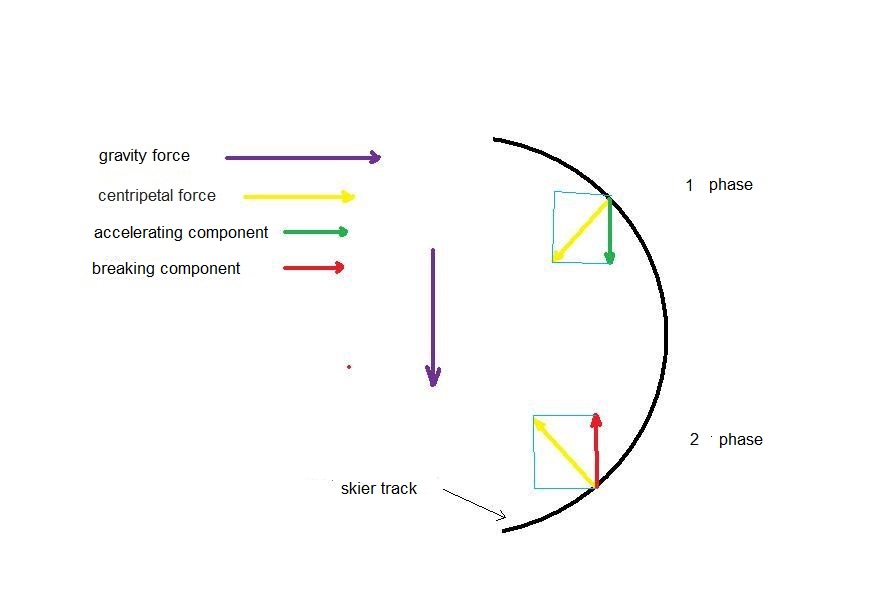Gravity is the strongest force that gives skiers speed. This is what accelerates the skier, but it is also the reason of difficulties in the slalom course and pulls him “down” when he needs to pass through the gates properly. During the turn, the force of gravity, always directed down the slope and towards the snow, has a component vector superimposed on the centripetal force, always directed towards the center of the turn. Let’s assume that a racer’s carving ski is loaded all the time and cuts a turn with a relatively constant, long enough radius. The slope is plane nad not steep. For the purposes of analysis, let’s divide this turn into 2 phases. The first – from the beginning of the turn to the slope fall line, the second from the fall line to the end of the turn. In the first phase, the pressure force on the ski, working perpendicularly to it, has its component, which supports the accelerating skier gravity and accelerates him even more. In the second phase, the same component works in the opposite direction and weakens the gravity force pulling the racer down the slope.
Let’s show it in the picture:

To go faster than others, the rider must support the “pull down” force. In the upper part of the turn he must develop as much pressure on the skis as possible. In the lower part he must minimize this pressure. This is the highest competitive skills.
How can we observe and evaluate it “live”? When pressed, even curved skis slip slightly, throwing some snow or ice aside. When the pressure is high, snow and ice gush out from under the skis and this can be seen clearly on the camera or TV screen. When a racer’s skis reject snow in the first phase of turning – it can be seen that he can accelerate. When too much snow appears in the second phase, you can see that he is braking. You do not have to wait for the result of time measurement, which will definitely confirm the observation.
It is a serious and difficult issue, how to initiate a strong pressure on the edges of the skis when starting the turn. I can’t provide only one solution here. Carving skis have enabled this method of acceleration, and the best competitors are looking for its optimization. Certainly with this search it is excluded to start the turn by going up, because it is in the first phase of the turn that you need to load the skis instead of unloading them. According to my observations, this load is currently made possible by starting the turn of the torso early enough, which is thrown into the new turn “down”, while the skis continue the previous turn. This prepares the base and the possibility of the earliest possible pressure on the new inner edges.
Minimizing the pressure on skis is a key problem in implementing the second turn phase. It seems to me that depending on the situation and driving technique, this can be done in two ways. The first, classic one, is performed by pulling the knees and feet up. If we ski as softly as possible, then of course, their pressure on the snow is small. This is a universal, the most commonly used method, which definitely must be used in short and fast turns. The second way to finish a turn can be a technique possible in longer turns. After aggressive and dynamic edging and pressure in the 1st half of the turn, we allow the ski to straighten in the turn second phase, recovering energy from it. This straightening ski, from which we released the aggressive pressure, can additionally “kick” the skier in the lateral direction while leaving the turn.